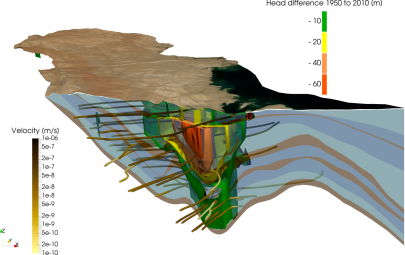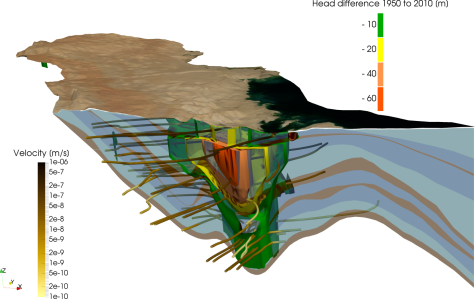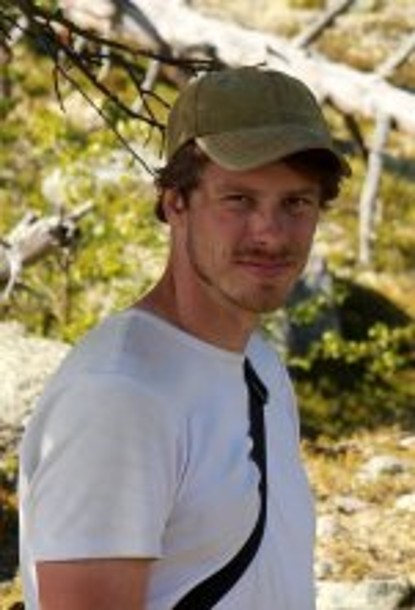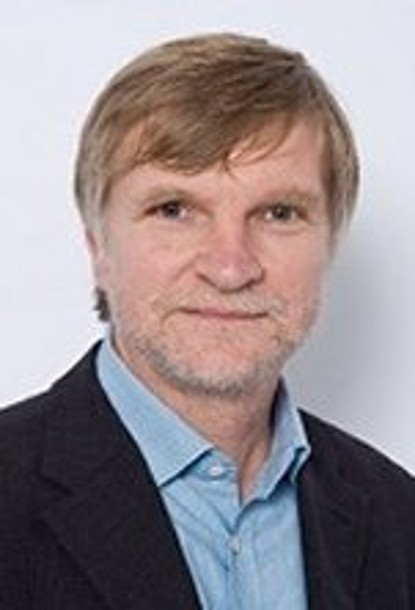Monitoring and modeling
Monitoring and modeling are closely related research fields and as such integral parts of hydrological studies. Hydro(geo)logical models help us to better understand hydrological processes and to make predictions. Thus, they became essential tools for water resources assessment and rehabilitation, but also for the energy sector, civil engineering, ecology, and socio-economy. However, the reliability of models strongly depends on the information on which they are based. Therefore, profound monitoring and exploration constitute fundamental prerequisites for a good modeling practice.
Within our working group groundwater models are applied for different scales and for different purposes. Currently, we are running models for groundwater resources assessment on the Arabian Peninsula, in Israel, in Ethiopia, and in Greece. Furthermore, we are simulating seawater intrusion in Bangladesh and the influence of mining activities on wetlands in Estonia.
The most common modeling software we are using in our group is MODFLOW, which we are operating with the graphical user interfaces ModelMuse and PMWIN. Moreover, we are a development partner of the open source software tool FREEWAT, which combines a geographical information system (QGIS) and MODFLOW. Another open source software we are using is OpenGeoSys, which is an extensive software package for the simulation of thermo-hydro-mechanical-chemical (THMC) processes. In order to meet the specific needs for our group, we developed own pre- and post-processing tools for OpenGeoSys. For model calibration we are using PEST as well as UCODE.
Furthermore, we are interested in the interaction between groundwater and surface water, e.g. groundwater recharge and evaporation from shallow groundwater. Thus, we also make use of coupled surface water and groundwater flow models (GSFLOW) and conceptual hydrological models like SWAT and J2000 (JAMS). We apply those models for case studies, e.g. in Germany, Jordan, Israel, Ethiopia, and Pakistan.
Working in remote areas and in developing countries is often associated with limited availability of ground data. To bridge this gap, within a number of studies we employ satellite remote sensing techniques, e.g. for model parameterization.
Contact: Dr. Stephan Schulz
Hydrochemistry and isotopes
Water analyses are an integral component of hydrogeological studies. Corresponding samples – either from the field or from batch or column experiments – can be screened for a wide range of parameters. Currently, our research includes aspects such as nitrate behaviour in the unsaturated and the saturated zone, chromium in river and groundwater (from Bangladesh’s tannery industry), and geogenic fluoride (in the Ethiopian Rift Valley). Moreover, seawater intrusion and salinization in general are of interest to our group.
Apart from hydrochemistry, environmental isotopes play an important role in our work. They represent a valuable addition to the hydrogeochemist’s toolbox and can be utilized to tackle a rather diverse range of hydrogeological questions.
Environmental isotopes can be divided into stable and radioactive ones. The former (e.g., 2 H, 18 O, 15 N-NO 3 – , 18 O-NO 3 – , 34 S-SO 4 2- , etc.) can be applied in various contexts, for instance for fingerprinting or to trace contaminant sources and degradation processes. Radionuclides, by contrast, are mainly used to estimate mean residence times of groundwater ( 3 H, 14 C-DIC). Moreover, a suite of nuclides that are frequently grouped under the term natural groundwater radioactivity ( 226 Ra, 228 Ra, 234 U, 238 U, etc.) is studied as part of our research. Their analysis serves two main purposes. On the one hand, they are relevant from a water quality perspective. On the other hand, they can also be useful tracers and serve as powerful fingerprinting tools. Finally, our group conducts Compound-Specific Isotope Analyses (CSIA) in cooperation with the Institute IWAR (Civil Engineering Department), to gain a better understanding of the origin and fate of organic groundwater contaminants.
More often than not, we combine hydrochemical investigations with isotope studies. The joint application of these tools frequently allows additional insights into processes that are otherwise difficult to disentangle.
The bulk of the corresponding analyses are carried out in our group’s laboratories (link). Parameters that are beyond the standard suite of analytes can be analyzed in the laboratories of cooperation partners such as IAF Radioökologie, IWW Zentrum Wasser, or Helmholtz-Centre for Environmental Research (UFZ).
Contact: Prof. Dr. Christoph Schüth





